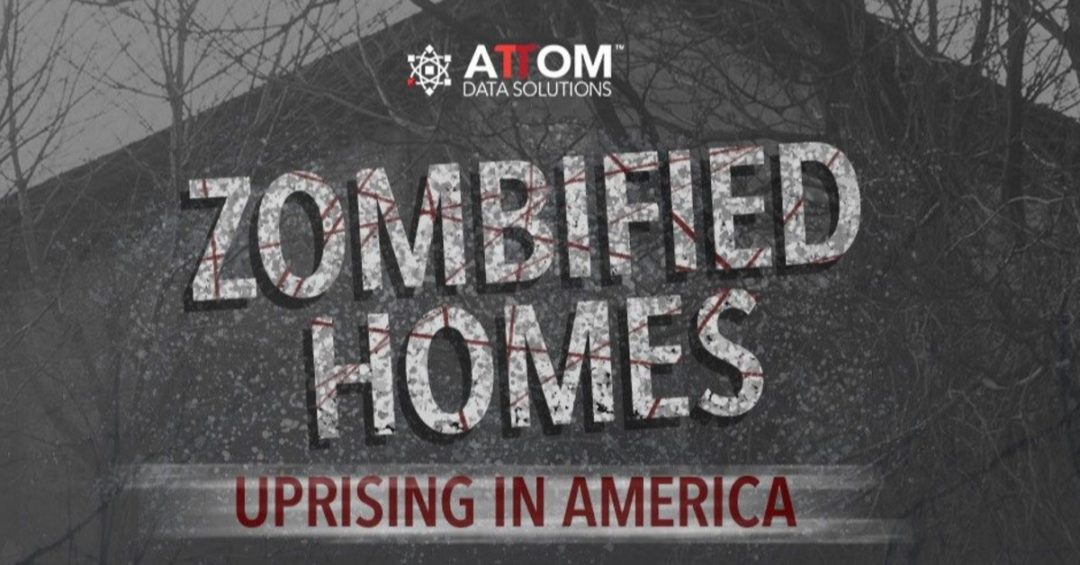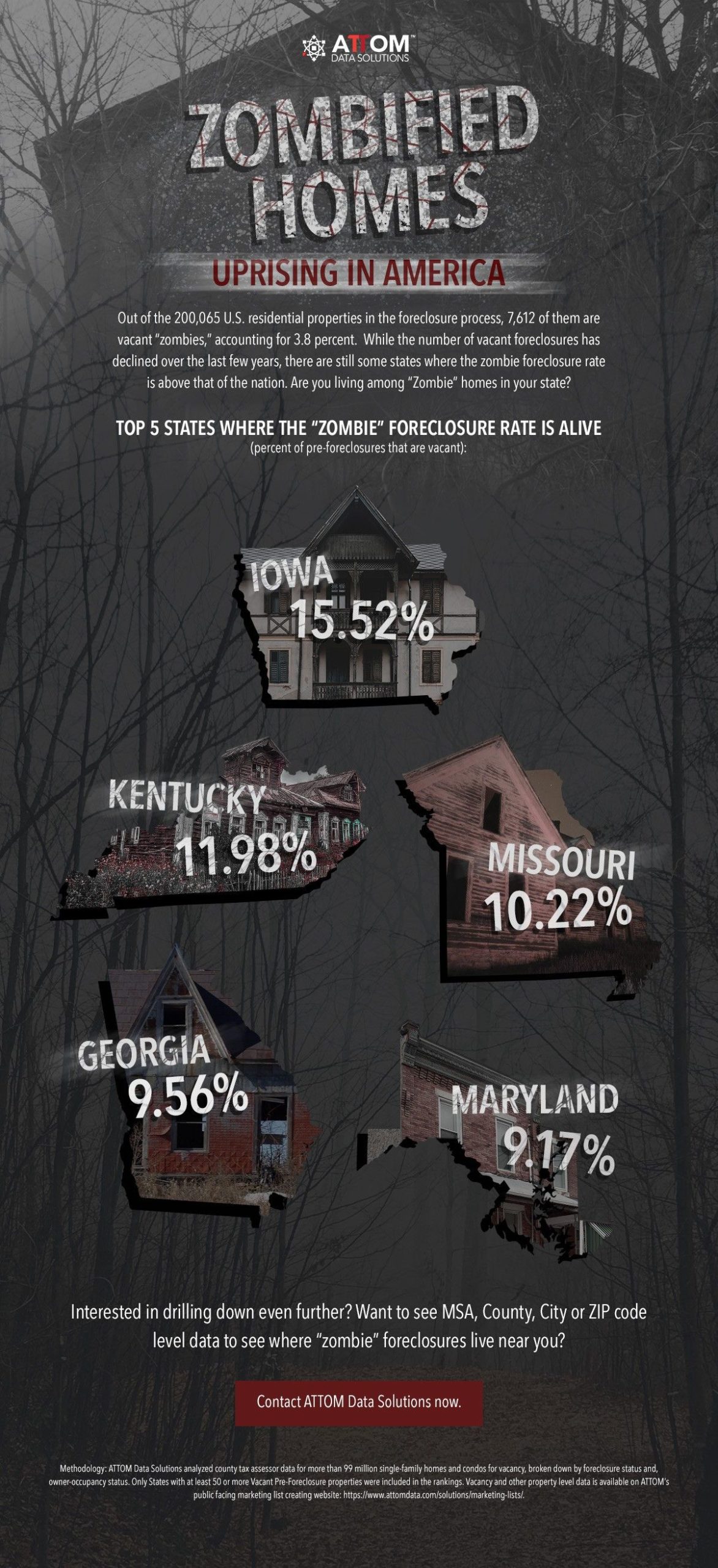
Number of Zombie Foreclosures Drops 4 percent From Last Quarter; Percentage of Foreclosure Properties Sitting Empty Stays About the Same; Among All Residential Properties, Zombie Foreclosures Represent Just One of Every 13,100
ATTOM Data Solutions, curator of the nation’s premier property database and first property data provider of Data-as-a-Service (DaaS), today released its fourth-quarter 2020 Vacant Property and Zombie Foreclosure Report (a current snapshot of the market in the fourth quarter) showing that 1.6 million (1,556,592) residential properties in the United States, representing 1.6 percent of all homes, are vacant.
The report analyzes publicly recorded real estate data collected by ATTOM Data Solutions — including foreclosure status, equity, and owner-occupancy status — matched against monthly updated vacancy data. (See full methodology enclosed below).
The report reveals that 200,065 properties are in the process of foreclosure in the fourth quarter, down 7.3 percent from the third quarter of 2020, while the number sitting empty (7,612) is down 4.4 percent.
The portion of pre-foreclosure properties that have been abandoned into zombie status has ticked up slightly, from 3.7 percent in the third quarter of 2020 to 3.8 percent this quarter.
Among the nation’s stock of 99.5 million residential properties, zombie properties continue to represent just a tiny fraction – only one of every 13,100 homes.
The fourth-quarter 2020 data shows a drop in the number of homes at some point in the foreclosure process and virtually the same rate of zombie foreclosures during a time when the federal government continues trying to shield the housing market from an economic slide stemming from the worldwide Coronavirus pandemic. A key measure remains a temporary prohibition against lenders foreclosing on government-backed mortgages. The ban, which is currently in place until December 31 and affects about 70 percent of home loans in the United States, was enacted under the CARES Act passed by Congress in March and then extended to help borrowers who have lost jobs or other sources of income during the pandemic. Some private lenders also have voluntarily offered mortgage extensions.
“Zombie foreclosures have been barely an issue around most of the country for over a year, and they’re even less of one now. A surprisingly strong housing market and a temporary ban on foreclosures continues to leave most neighborhoods without a single such property,” said Todd Teta, chief product officer with ATTOM Data Solutions. “All that could change in a flash when foreclosures are allowed to resume or if the Coronavirus takes a toll on the market. But for now, things are steady as they go, with the overall numbers down and the rates of zombie properties pretty much unchanged.”
Midwest and South have highest zombie foreclosures rates
A total of 7,612 residential properties facing possible foreclosure have been vacated by their owners nationwide in the fourth quarter of 2020. That figure comprises 3.8 percent, or one in 26, of all properties in the foreclosure process. Those numbers are up slightly from 3.7 percent, or one in 27, in the third quarter of 2020, and up from 3 percent, or one in 34 properties, the fourth quarter of 2019.
States with the highest zombie foreclosure rates remain clustered in the Midwest and South. The top rates among states with at least 50 properties in foreclosure and vacant include Iowa (15.5 percent, or one in six properties in the foreclosure process), Kentucky (12 percent, or one in eight), Missouri (10.2 percent, or one in 10), Georgia (9.6 percent, or one in 10), and Maryland (9.2 percent, or one in nine).

“It’s worth noting that while foreclosure moratoria have caused the number of zombie properties to drop slightly, the percentage of foreclosure properties in zombie status has increased,” said Rick Sharga, executive vice president for RealtyTrac, an ATTOM Data Solutions company. “It’s likely that as the length of time it takes to execute a foreclosure continues to increase, we’ll also continue to see the percentage of vacant and abandoned foreclosure homes increase.”
States with the lowest rates are mostly in the Northeast and West, including Utah (1.3 percent, or one in 76 properties in the foreclosure process), Colorado (1.6 percent, or one in 62), New Jersey (1.7 percent, or one in 61), Idaho (2.2 percent, or one in 47) and California (2.2 percent, or one in 46). (Ratios may differ due to rounding).
Zombie rates rise in 37 states and DC
Zombie-foreclosure rates rose from the third quarter to the fourth quarter of 2020 in 37 states and the District of Columbia. States with at least 100 properties in the foreclosure process and the largest increases include Iowa (up from 10.3 percent to 15.5 percent of all properties in the foreclosure process), Delaware (up from 3.7 percent to 8 percent), Oregon (up from 5.1 percent to 9.2 percent), Mississippi (up from 8.7 percent to 12.2 percent) and Maryland (up from 7 percent to 9.2 percent).
Highest numbers of zombie properties remain in northeastern and midwestern states
New York continues to have the highest actual number of zombie properties (2,131), followed by Florida (1,027), Illinois (934), Ohio (836), and New Jersey (346). California leads in the West, with 234.
“Some of the states with the highest rate of zombie foreclosure properties are also states that have been among the hardest hit by the COVID-19 pandemic,” Sharga noted. “When the government bans on foreclosure activity expire, it wouldn’t be a surprise to see the number of defaults in those states increase more rapidly than in other parts of the country, and the number of zombie foreclosure properties rise more dramatically in those states as well.”
Northeast and Midwest also have highest ratios of zombie foreclosure as portion of all residential properties
Despite increases in the rates of zombie foreclosures in the fourth quarter of 2020, those properties represent just one in every 13,074 residential properties of all kinds in the United States, including those not facing possible bank takeover.
States with the highest ratios are concentrated in the Northeast and Midwest, led by New York (one in 1,941 properties), Illinois (one in 4,243), Ohio (one in 4,592), Florida (one in 6,757) and New Jersey (one in 7,692). New Mexico has the highest ratio in the West (one in 7,692).
States with the lowest ratios include New Hampshire (one in 155,649 properties), Idaho (one in 142,850), West Virginia (one in 132,594), Vermont (one in 128,439) and Arkansas (one in 127,209).
Other high-level findings from fourth-quarter data:
To learn more about the data behind this article and what Attom Data Solutions has to offer, visit https://www.attomdata.com/.







Sign up to receive our stories in your inbox.
Data is changing the speed of business. Investors, Corporations, and Governments are buying new, differentiated data to gain visibility make better decisions. Don't fall behind. Let us help.



















Sign up to receive our stories in your inbox.
Data is changing the speed of business. Investors, Corporations, and Governments are buying new, differentiated data to gain visibility make better decisions. Don't fall behind. Let us help.











